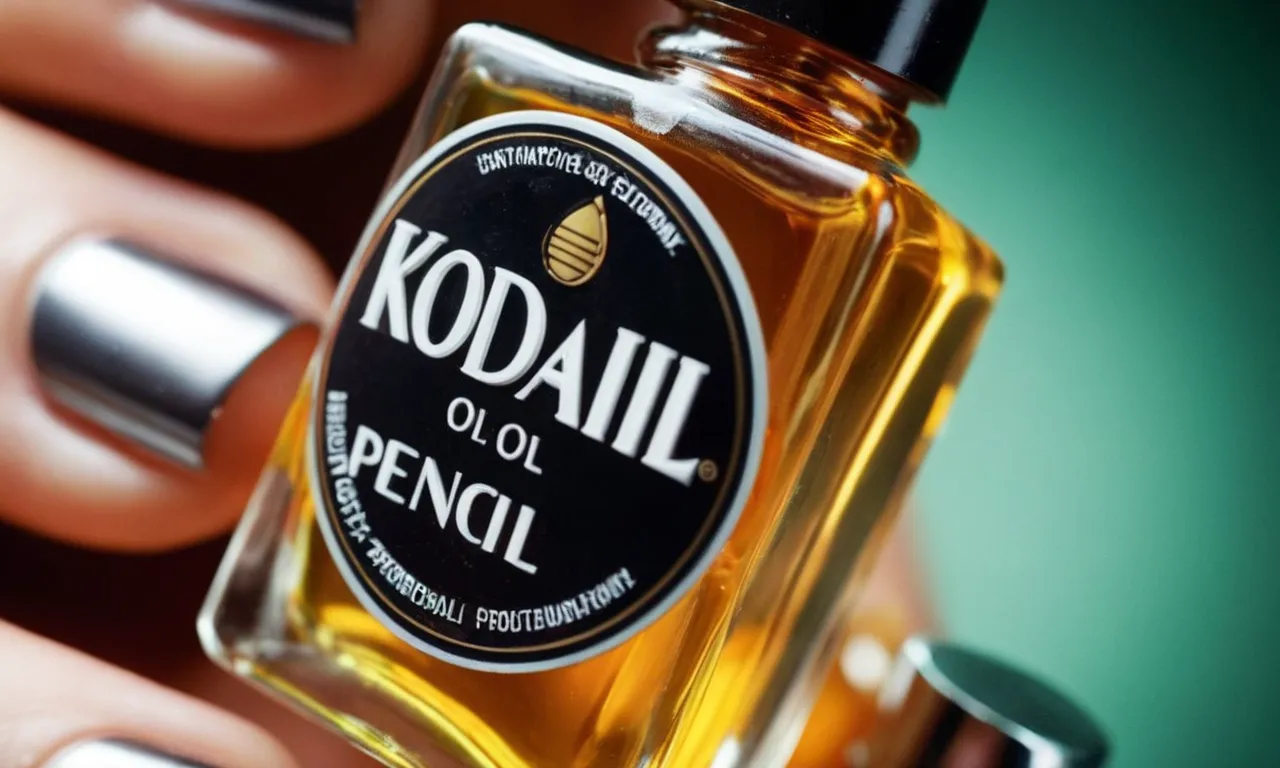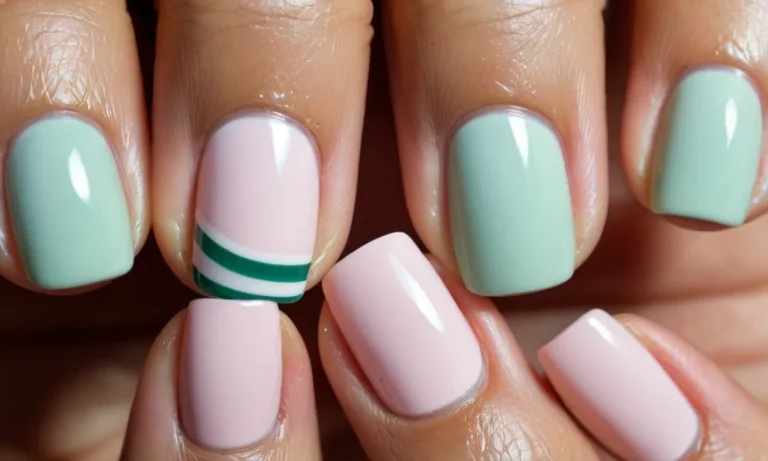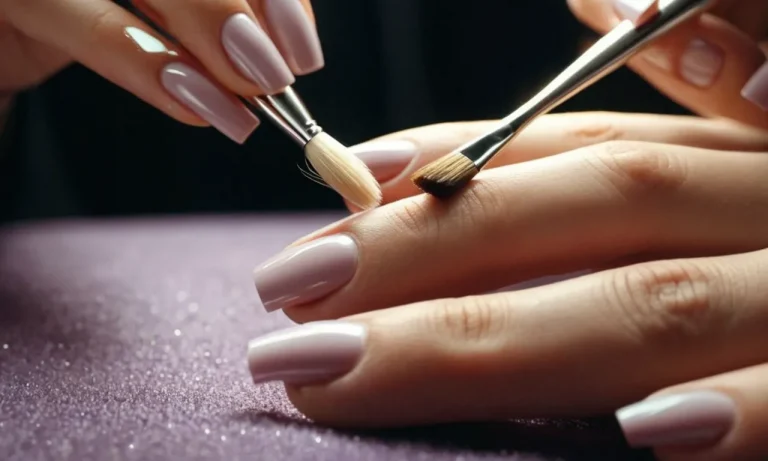Anti Fungal Oils For Nails: A Complete Guide
Fungal infections of the nails, known as onychomycosis, are a common problem that can leave nails discolored, thickened, brittle, and ugly. Getting rid of nail fungus can be challenging, but using anti fungal oils is an effective natural treatment option for many people.
If you’re short on time, here’s a quick answer: Tea tree oil, oregano oil, neem oil, grapefruit seed extract oil, and lemon essential oil applied directly to nails and cuticles can help kill stubborn nail fungus infections when used consistently over time.
In this comprehensive guide, we will cover everything you need to know about using anti fungal oils to treat nail fungus, including:
What Causes Nail Fungus
Dermatophytes Fungus
Dermatophytes are fungi that require keratin for growth. Keratin is a protein that makes up the hard surface layer of nails. There are several types of dermatophytes that can infect nails and cause fungal nail infections including Trichophyton rubrum, Trichophyton mentagrophytes, and Epidermophyton floccosum.
These microscopic organisms thrive in warm, moist areas like showers, locker rooms, and swimming pools.
Dermatophytes fungus often invades the nail through a tiny cut or break in the nail bed and cuticle. As the infection progresses, the nail becomes thickened and discolored as debris accumulates under the nail. The debris consists of bits of keratin produced by the fungus as it invades the nail plate.
If left untreated, dermatophytes fungus can spread to other nails. The infection can also spread to the skin around the nail and in rare cases, into deeper tissues. Therefore, prompt treatment is recommended when dermatophyte fungus is detected.
Yeasts and Molds
Besides dermatophytes fungus, yeasts and molds are other microorganisms that can infect nails and trigger fungal nail disease. Candida albicans is the most common yeast that causes nail fungus. Candida naturally lives on our skin but can sometimes overgrow and lead to infection.
This yeast thrives in warm, moist environments.
People with diabetes have a higher risk of developing candida nail infections. The high blood sugar associated with diabetes provides favorable conditions for yeast to flourish. Other risk factors include wearing tight-fitting shoes, having hyperhidrosis (excessive sweating), walking barefoot in damp public areas, and a weakened immune system.
Molds that infect nails include Aspergillus, Fusarium, and Scopulariopsis species. They are less common causes of nail fungus compared to dermatophytes and candida yeast. However, in people with a compromised immune system, mold infections can become serious and spread.
Like dermatophytes fungus, yeasts and molds invade the nail through damage to the nail bed, cuticle, or surrounding skin. As the infection progresses, the nail becomes disfigured, thickened, discolored, and crumbly.
Symptoms of Nail Fungus
Thickened Nails
One of the most common symptoms of a nail fungus infection is a gradual thickening and deformity of the nail (1). As the infection progresses, the nail often becomes darker in color and dull looking. The thickening is caused by a buildup of the keratinous material that makes up most of the nail plate.
Discolored Nails
In addition to thickening, nail fungus infections often lead to discoloration of the nail (2). The nail may turn white, yellow, brown, or green. Sometimes nail fungus causes dark streaks or dots on the nail.
The discoloration occurs when the accumulation of keratin (nail material) caused by the infection leads to a change in the light reflection properties of the nail.
Brittle, Crumbly Nails
Fungal infections that persist for a long time weaken the nail, making it soft, brittle, and crumbly (3). Pieces of the nail may chip off or break away completely. This happens when the networks of keratin fibers that make up the nail are damaged by the continuing fungal infection.
The brittleness can become so severe that the nail partially or fully crumbles away.
Distorted Nail Shape
As the nail fungus infection worsens, it often leads to a distortion in the shape of the nail (4). The nail may detach from the nail bed, become wavy or bumpy, curve downward, develop grooves, or thicken unevenly.
This irregular nail shape occurs because the fungus interferes with the growth of new keratin fibers in some areas but not others.
Debris Under Nails
Fungal nail infections can cause a buildup of debris underneath the nail (5). This debris is made up of tiny fragments of keratin and fungal particles. It appears as a yellowish-white or brown-black discoloration under the tip of the nail.
This is often one of the first symptoms of a nail fungus infection.
Foul Smell
Finally, a persistent nail fungal infection sometimes produces a foul odor in the nail (2). This occurs when the accumulating debris under and around the nail starts to decompose. The smell is often described as musty or unpleasant.
While not the most common symptom, a foul smell can be a telltale sign of advanced nail fungus.
Risk Factors for Developing Nail Fungus
Damage to Nail or Surrounding Skin
Nails can become more susceptible to fungal infection when the nail bed or surrounding skin is damaged. Small injuries like ingrown toenails, hangnails, cuts, bites, burns and other trauma allow fungi to bypass the protective barrier of the skin and infect the nail bed.
Keeping toenails trimmed straight across and avoiding tight shoes can prevent ingrown toenails. Moisturizing the nails and cuticles daily helps keep the skin supple and less prone to cracking.
Reduced Blood Circulation
Good blood flow brings immune cells to an area to help fight infection. Conditions that reduce blood circulation like diabetes, peripheral artery disease and Raynaud’s syndrome put people at higher risk for nail fungus.
Managing underlying health conditions improves blood flow and helps prevent fungal growth.
Weakened Immune System
People with weakened immune systems due to illness or medical treatments like chemotherapy are more susceptible to nail fungus. HIV/AIDS, immunosuppressant drugs, and autoimmune disorders like lupus also compromise the body’s ability to fight infection.
While little can be done to strengthen immunity in these cases, practicing good nail hygiene can help reduce exposure to fungi.
Age
The risk of nail fungus increases with age. As we get older, blood circulation tends to decrease along with nail growth, making them more vulnerable to infection. Older adults also often have other medical conditions that affect immunity and blood flow.
Keeping nails short and dry can help reduce fungal infection in older individuals.
Gender
Men are more prone to nail fungus than women, likely due to greater exposure to environments where fungi thrive. Work boots worn daily without rotation, and athletic shoes worn without socks or drying out between uses, create warm, moist environments perfect for fungal growth.
Using antifungal foot powder in shoes and socks, and alternating pairs of shoes, can help decrease fungal infection in men.
Genetics and Family History
Fungal nail infection can run in families. Having a blood relative with chronic fungus may increase your risk due to shared genetic susceptibility. However, family members also have similar environments and behaviors that can spread infection.
Washing hands after touching infected nails, disinfecting shower floors, avoiding shared towels, and replacing old shoes and socks, can help stop the spread of fungus within a family.
Lifestyle Factors
Certain activities and environments raise the risk of nail fungus. Swimmers or runners who use public showers and pools, as well as sharing locker room facilities, are vulnerable due to damp floors and surfaces where fungi live.
Jobs requiring prolonged glove use like healthcare, food services, and construction, create a dark, warm environment for fungal growth. Wearing plastic gloves under work gloves, frequently changing gloves, and alternating pairs of work shoes improve airflow and help prevent nail fungus.
When to See a Doctor
Fungal nail infections can often be treated at home with over-the-counter antifungal products. However, in some cases it’s important to see your doctor for an evaluation and possible prescription treatment.
Severe Infection
If your nail fungal infection is severe and worsens despite using OTC antifungal treatments for several months, it’s time to make an appointment with your doctor. They can examine your nails, confirm it is a fungal infection, and may prescribe you a stronger oral or topical antifungal medication.
Painful Infection
While the most common symptom is thickened, discolored nails, some people have pain and swelling. This can indicate a secondary bacterial infection that needs antibiotic treatment in addition to antifungals. See your doctor right away if your infected nail is painful.
Other Medical Conditions
Sometimes nail problems may have causes other than fungal infections, including:
- Psoriasis
- Lichen planus
- Skin cancer
It’s important to get an accurate diagnosis, so if OTC antifungals aren’t working after a few months or you have other concerning symptoms like nail separation from the nail bed, make an appointment with your doctor for proper diagnosis and treatment.
People at High Risk
You should also see your doctor promptly about nail fungus if you have diabetes, suppressed immune system, or poor circulation. These conditions put you at higher risk for secondary bacterial infections and other complications, which need medical care.
Anti Fungal Oils for Treating Nail Fungus
Tea Tree Oil
Tea tree oil is one of the most popular natural antifungal treatments. It contains terpinen-4-ol, which gives it powerful antifungal properties. Multiple studies have shown that tea tree oil is effective against dermatophytes, a common cause of nail fungus (1, 2).
One study found tea tree oil cleared up nail fungus in 6 out of 10 people when applied twice daily for 3 months (3).
Oregano Oil
Oregano oil also has strong antifungal abilities. One study showed that oregano oil was effective against five different types of Candida, another common cause of fungal infections (4). Oregano oil contains thymol and carvacrol, two powerful compounds that have been shown to fight against nail fungus (5).
However, more research is needed to confirm oregano oil’s effectiveness on treating nail infections.
Neem Oil
Extracted from the neem tree, neem oil is known for its antifungal effects. One study found neem oil was able to inhibit the growth of certain dermatophytes that commonly cause nail infections (6). Another study showed neem oil was effective against four different types of fungi (7).
Neem oil contains gedunin and nimbidol, two compounds that are thought to be responsible for its antifungal effects.
Grapefruit Seed Extract
Grapefruit seed extract is made from the seeds of grapefruits. It contains beneficial plant compounds like limonoids that have been shown to have antifungal abilities. According to one test-tube study, grapefruit seed extract was effective at inhibiting the growth of certain types of fungi, including Candida (8).
More research is needed to confirm its effects on treating nail fungus.
Lemon Essential Oil
Lemon essential oil has antifungal properties and can be used to help treat nail fungus. One study found that lemon oil was able to inhibit the growth of certain types of fungi (9). Another small study showed that lemon oil application for 6 months helped clear yellow nail fungus in 8 out of 10 people (10).
However, these studies are limited and more research is still needed.
How to Apply Anti Fungal Oils to Nails
Here are some tips on using anti fungal oils to treat nail fungus:
- Clean and fully dry the affected nails before applying the oil.
- Use a dropper or cotton swab to apply a few drops of oil directly onto the infected nail and surrounding skin.
- Gently massage the oil into the nail bed and surrounding skin to fully absorb it.
- Apply the oil 1-2 times per day, ideally morning and night.
- Continue using the oil daily for several months until the fungus clears.
- Be patient – it can take 2-3 months or longer to fully treat the fungal infection.
- Consider combining the oil treatment with oral anti-fungal medication for more severe cases.
Essential oils like tea tree oil, oregano oil, and lemon oil appear to be effective natural treatments against nail fungus according to some studies. However, more research is still needed. Be sure to dilute essential oils and test for skin sensitivity before wider application.
And consult a doctor if the infection persists. With patience and consistency, anti fungal oils may help treat stubborn fungal nail infections.
Other Natural Anti Fungal Remedies
Apple Cider Vinegar
Apple cider vinegar is a commonly used household ingredient that has antifungal properties. Studies show that acetic acid, the main active component of apple cider vinegar, can effectively inhibit the growth of several types of fungi and yeasts (1).
Try mixing equal parts apple cider vinegar and water and applying it to affected nails using a cotton ball twice daily until symptoms subside.
Vicks VapoRub
The camphor and menthol in Vicks VapoRub give it natural antifungal abilities. A 2011 study found Vicks VapoRub to be effective against toenail fungus, with 13 out of 18 patients showing complete clinical improvement (2). Apply a small amount of Vicks VapoRub to affected nails once or twice per day.
Baking Soda
Baking soda has mild antifungal effects and may help balance skin pH to discourage fungal growth (3). Create a paste using a few teaspoons of baking soda and water. Apply to nails, let sit for 10 minutes, then rinse. Repeat 1–2 times daily as needed.
Oregano Essential Oil
Oregano oil contains compounds like carvacrol and thymol, which have powerful antifungal properties (4). One test-tube study showed that oregano oil was effective against five different types of fungi (5).
Mix a few drops of oregano essential oil with a carrier oil like olive or coconut oil and apply to nails twice daily.
Garlic
Garlic contains a compound called allicin, which has been shown to inhibit fungal growth and infection in animal and test-tube studies (6). Mince a few cloves of garlic and add to one tablespoon of coconut oil. Let sit for 10 minutes, then strain.
Apply the garlic-infused oil to affected nails 1–2 times per day.
Hydrogen Peroxide
The antibacterial and antifungal properties of hydrogen peroxide may make it useful against nail fungus (7). Mix equal parts hydrogen peroxide and water and use a cotton swab to apply it to the nail beds daily. Rinse thoroughly and pat dry after 10–15 minutes.
Epsom Salt Soaks
Epsom salts may have antifungal effects and can help dry out excess moisture that fungal infections thrive on. Dissolve 1/2 cup of Epsom salts in warm water and soak affected nails for 15 minutes daily (8). Make sure to thoroughly dry your feet afterward.
Essential Oil Blends
Certain essential oils like tea tree oil, clove oil, lemongrass oil, and thyme oil have natural antifungal abilities (9). Try mixing a few drops each of 2-3 of these oils with a carrier oil and apply to nails once or twice daily. Some examples of effective combinations may include:
- Tea tree + lemongrass
- Oregano + thyme
- Clove + tea tree
When to See Results and How Long Treatment Takes
When using antifungal oils to treat nail fungus, it’s normal to wonder how long it will take to see results. The timeline can vary quite a bit depending on the severity of the infection, how consistently the oil is applied, and the particular oil used. Here’s a general overview of what to expect:
Mild Cases
For mild fungal nail infections limited to the tip of the nail, you may start seeing improvement within 4-6 weeks of beginning antifungal oil application. Look for the infected part of the nail to start growing out and the discolored or distorted nail to move towards the tip as new, healthy nail grows in behind it.
Moderate Cases
When about half or more of the nail is infected, it typically takes 2-3 months to start seeing noticeable results from using antifungal oils. Improvement often starts as a clearing of the infection at the base of the nail, by the cuticle and nail bed, that gradually moves outward.
Severe Cases
With severe fungal nail infections involving the entire nail and/or nail loss, it can take 4-6 months or longer before you see significant improvement with antifungal oils. In some cases, it may take 9-12 months for a completely new, healthy nail to grow in.
Application Consistency
For best results, it’s important to apply antifungal oils consistently 1-2 times per day over the full treatment period. Sporadic applications are less effective. Nail fungus can be stubborn, so committing to regular application is key.
Type of Oil
Tea tree oil and oregano oil tend to show results more quickly compared to oils like coconut, jojoba, or lavender oil. However, combining oils can boost effectiveness. For example, mixing a few drops of tea tree oil into coconut or jojoba oil as a base.
This takes advantage of the antimicrobial powers of tea tree oil along with the deep nail penetration of oils like coconut.
Lifestyle Factors
In addition to diligent oil application, other actions can help speed up results. Keeping nails trimmed short, avoiding repeated trauma to nails, wearing breathable shoes and socks, avoiding share of nail care tools, and managing underlying medical conditions like diabetes will support quicker nail fungus clearing.
Professional Care
Seeing a podiatrist or dermatologist for professional debridement, oral antifungal medications, or laser treatments can shorten treatment timelines, especially for severe or persistent fungal nail infections.
Some studies have shown combining antifungal oils with prescription antifungals improves results.
Patience and persistence are important when using antifungal oils to treat nail fungus. While it can take months to fully clear an infection, natural oils provide a safe and effective option. Be diligent with application and combine with other nail health strategies to help get your nails back to a healthy state as quickly as possible.
Tips for Prevention
Wear Breathable Footwear
Wearing closed-toe shoes and sneakers that lack ventilation can cause a buildup of moisture around the nails, creating the warm, damp environment in which fungi thrive. Instead, opt for sandals when possible to allow air to circulate around the feet and nails.
Breathable footwear options like canvas shoes or leather Oxfords with perforations can also help.
Change Socks Regularly
Frequently changing out of damp, sweaty socks deprives fungi of the moist environment they need to take hold. Make it a habit to put on a fresh pair of clean, dry socks at least once a day. For those with excessive sweating or athletes, changing socks more often may be necessary.
Don’t Share Footwear or Tools
Sharing shoes or nail care tools with others exposes you to fungi that could be present on the items. Have designated personal footwear, and don’t share nail clippers, files, or other manicure tools. Even trace amounts left behind by someone else could transfer an infection.
Disinfect Pedicure Tools
Pedicure tools and foot baths at nail salons can harbor fungus spores if not properly disinfected between clients. Observe technicians to ensure tools are thoroughly cleaned and consider bringing your own that haven’t been used by others if you’re prone to fungal infections.
Get Pedicures Cautiously
Even when pedicure tools are sanitized, fungi living under the nail beds of previous customers can be transferred if technicians use the same nail files or clippers. Ask that unused disposable tools be opened in front of you.
Skip callus removal that risks breaking the skin, as fungi can enter through cracks in the skin.
Treat Athlete’s Foot Promptly
According to the CDC, about 70% of fungal nail infections start from athlete’s foot spreading to the nails. Treating athlete’s foot as soon as symptoms appear, like scaling or cracked skin between the toes, can prevent fungus from spreading further.
Moisturize Feet and Nails
Regular moisturization keeps skin supple and less prone to cracking, denying fungi an entry point under nails. Massage oil or thick creams like petroleum jelly into nail beds and cuticles daily. Seal in moisture at night by wearing cotton socks.
Trim Nails Properly
Clip nails straight across to prevent painful ingrown toenails, which create openings for fungus. Don’t trim nails too short or file to thin edges, as this risks breaking nails and exposing entry points. Use sharp sterilized nail clippers only on your own nails to avoid transmission.
Conclusion
Nail fungus can be persistent, but anti fungal oils provide a safe and effective natural treatment option. Oils like tea tree, oregano, neem, grapefruit seed extract, and lemon essential oils contain powerful antifungal properties and can penetrate nails to kill infection when applied consistently.
Using these oils as directed along with other natural remedies and prevention tips can help get rid of nail fungus and restore healthy-looking nails over time. Be patient, commit to daily treatment, and in most cases you will begin to see clearing of infections within a few months.







